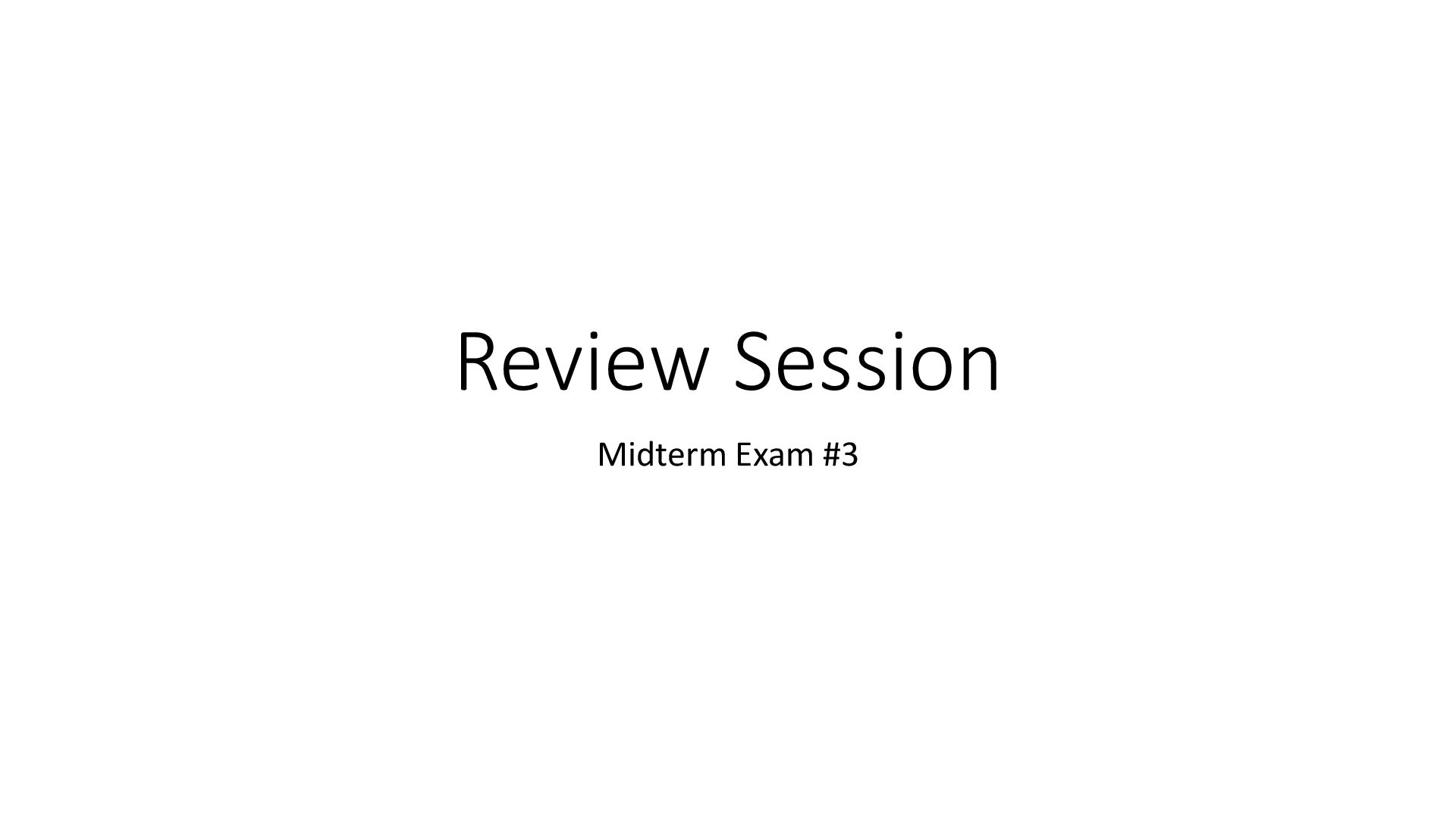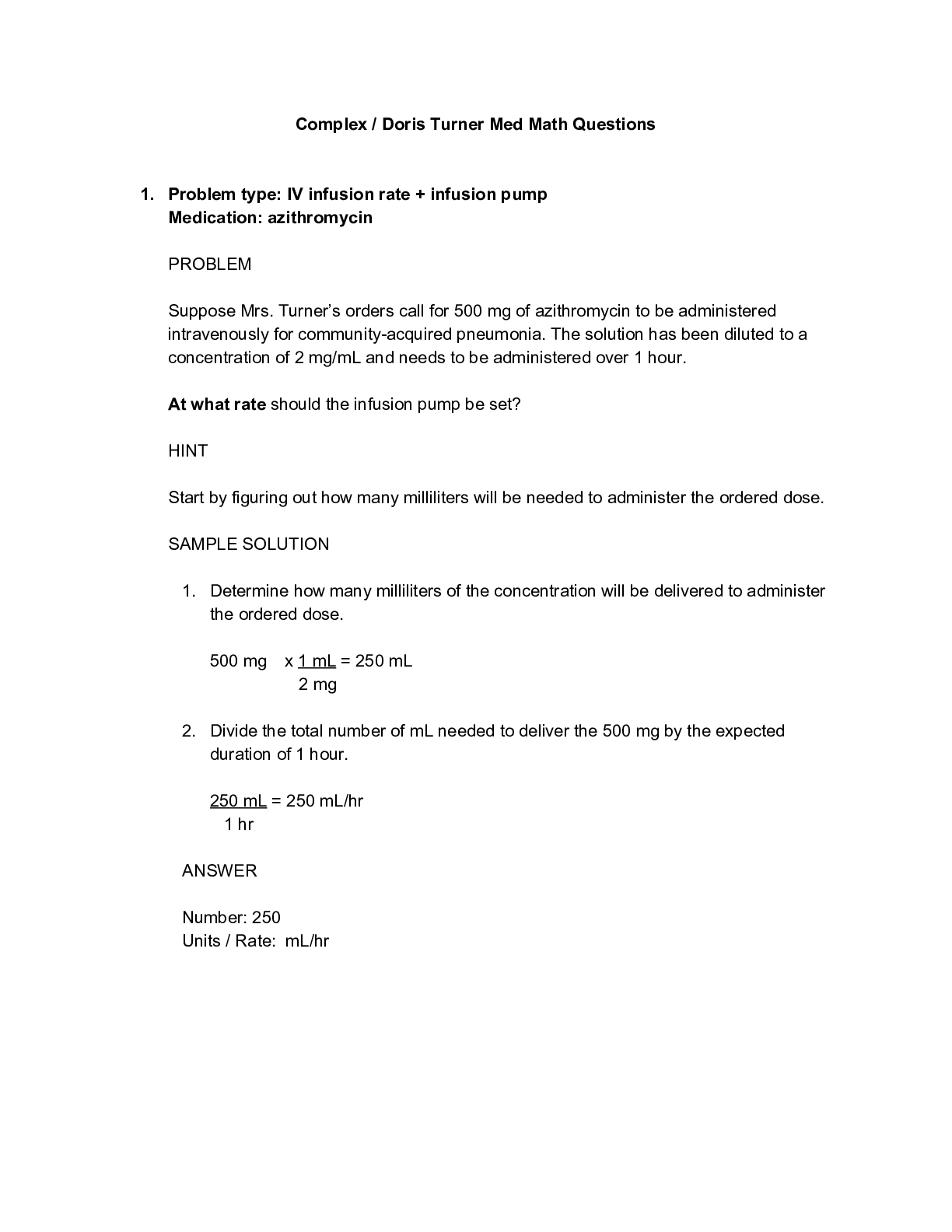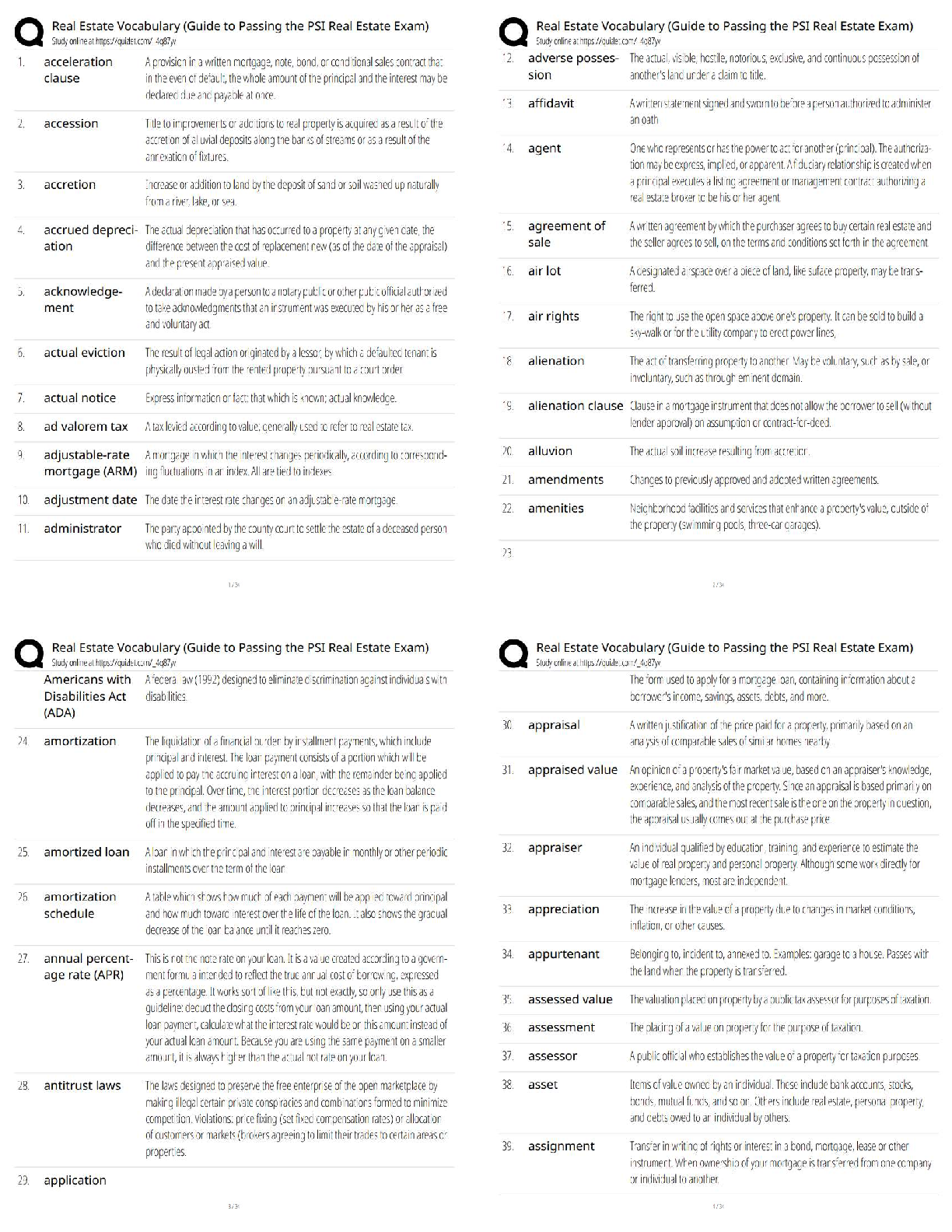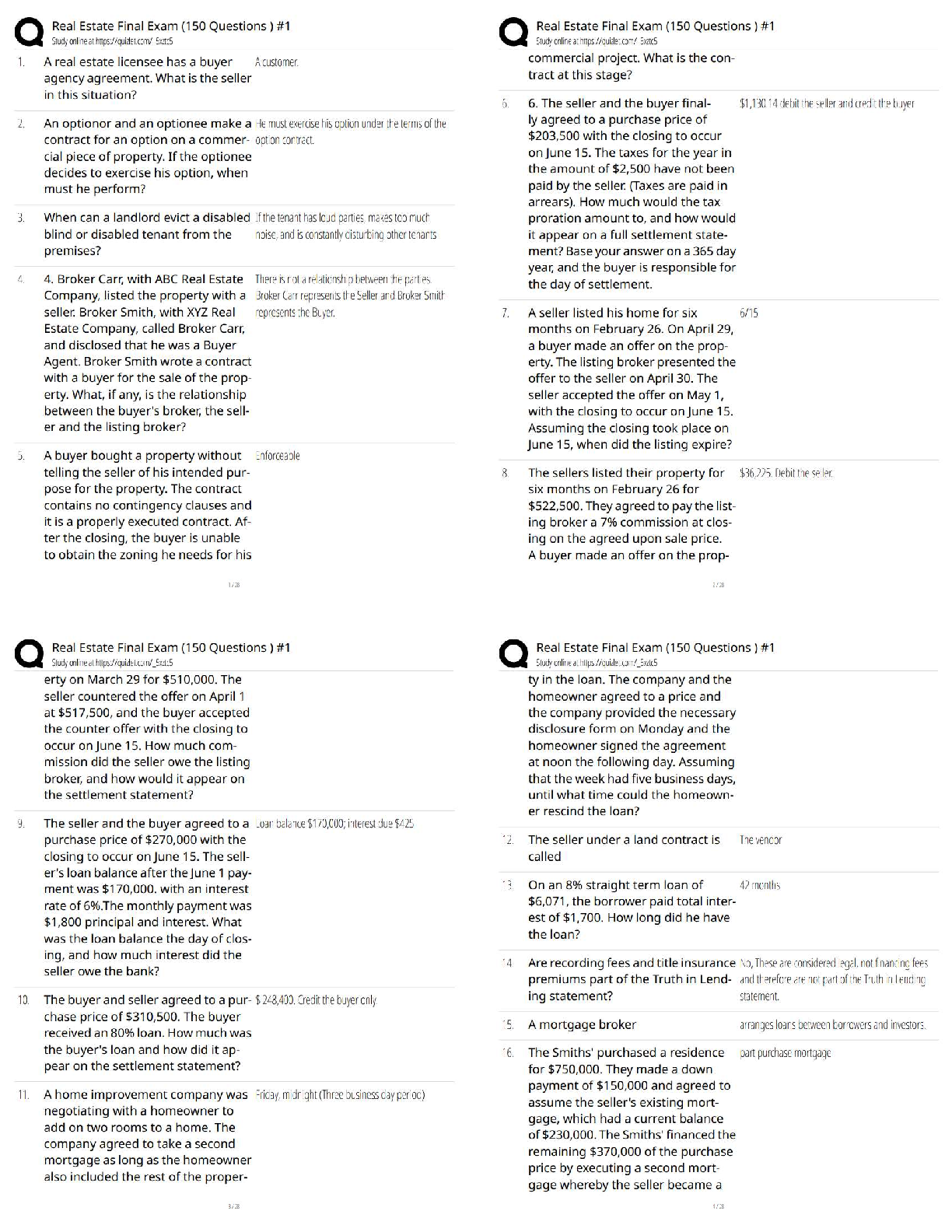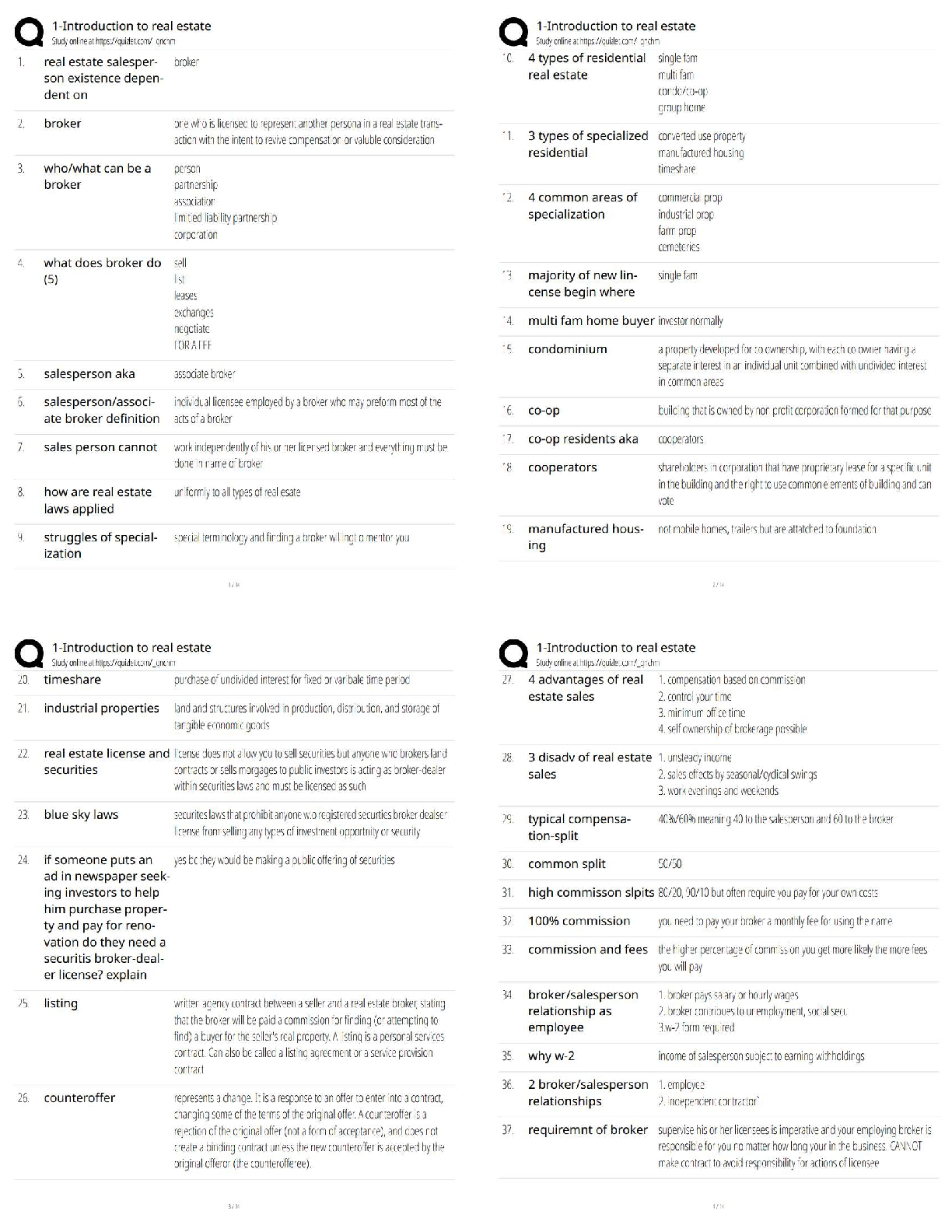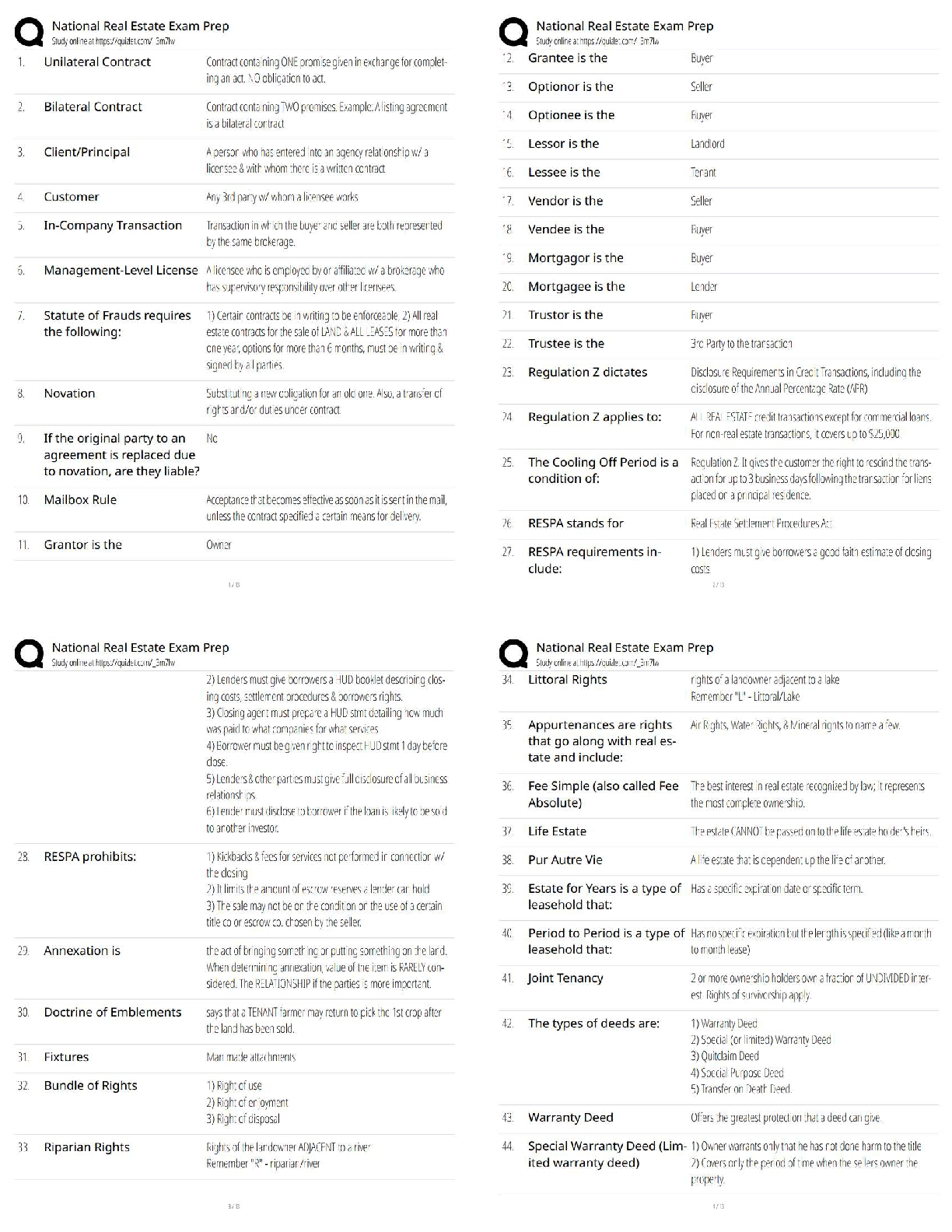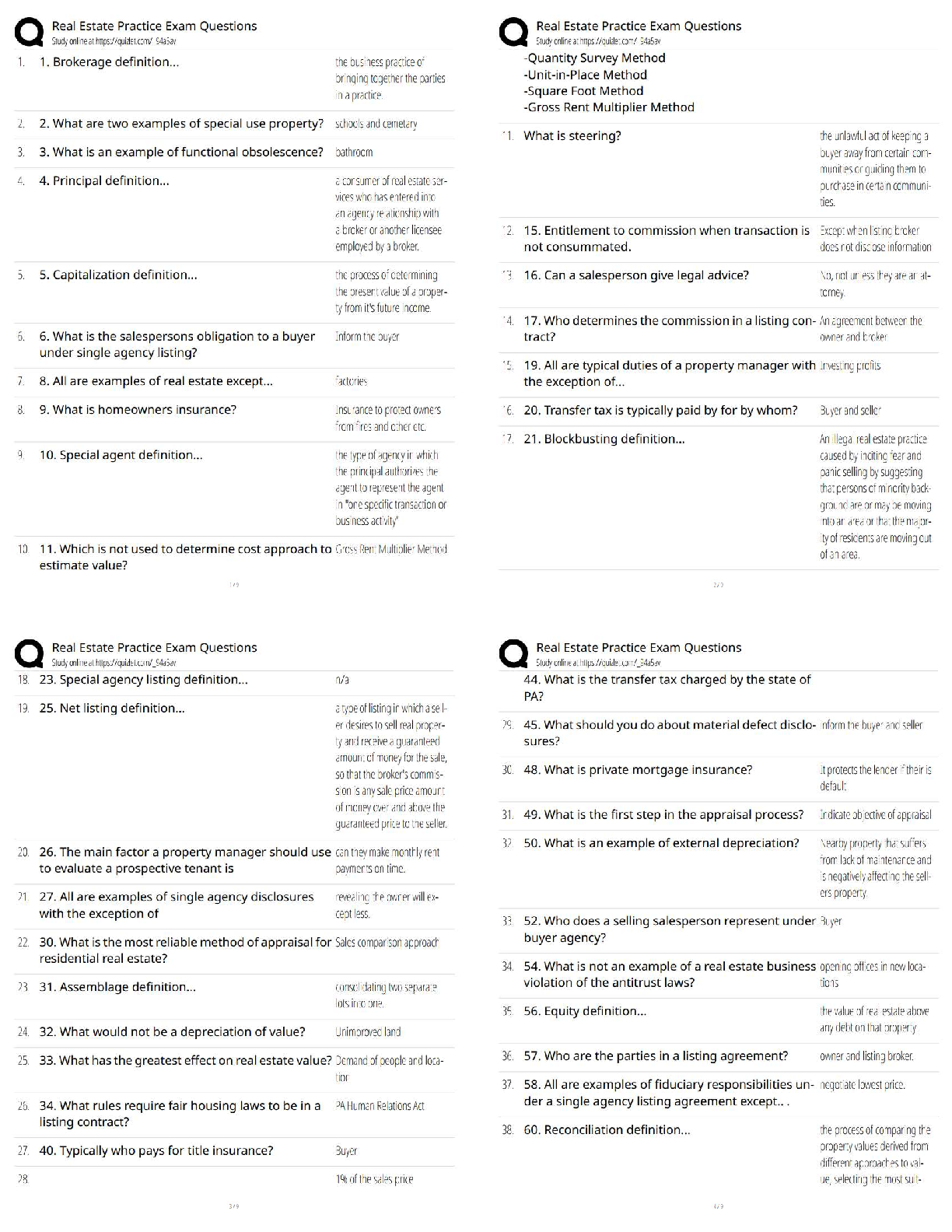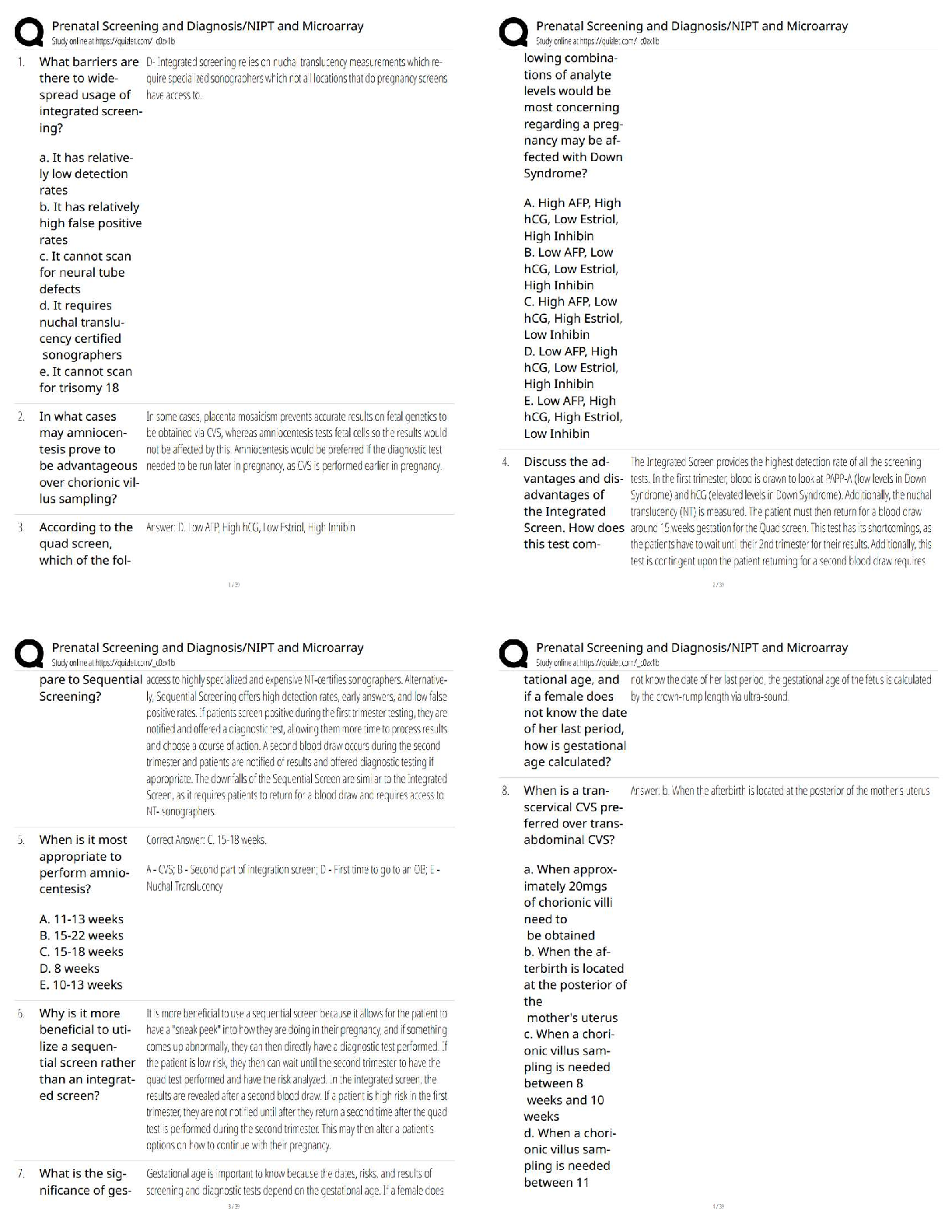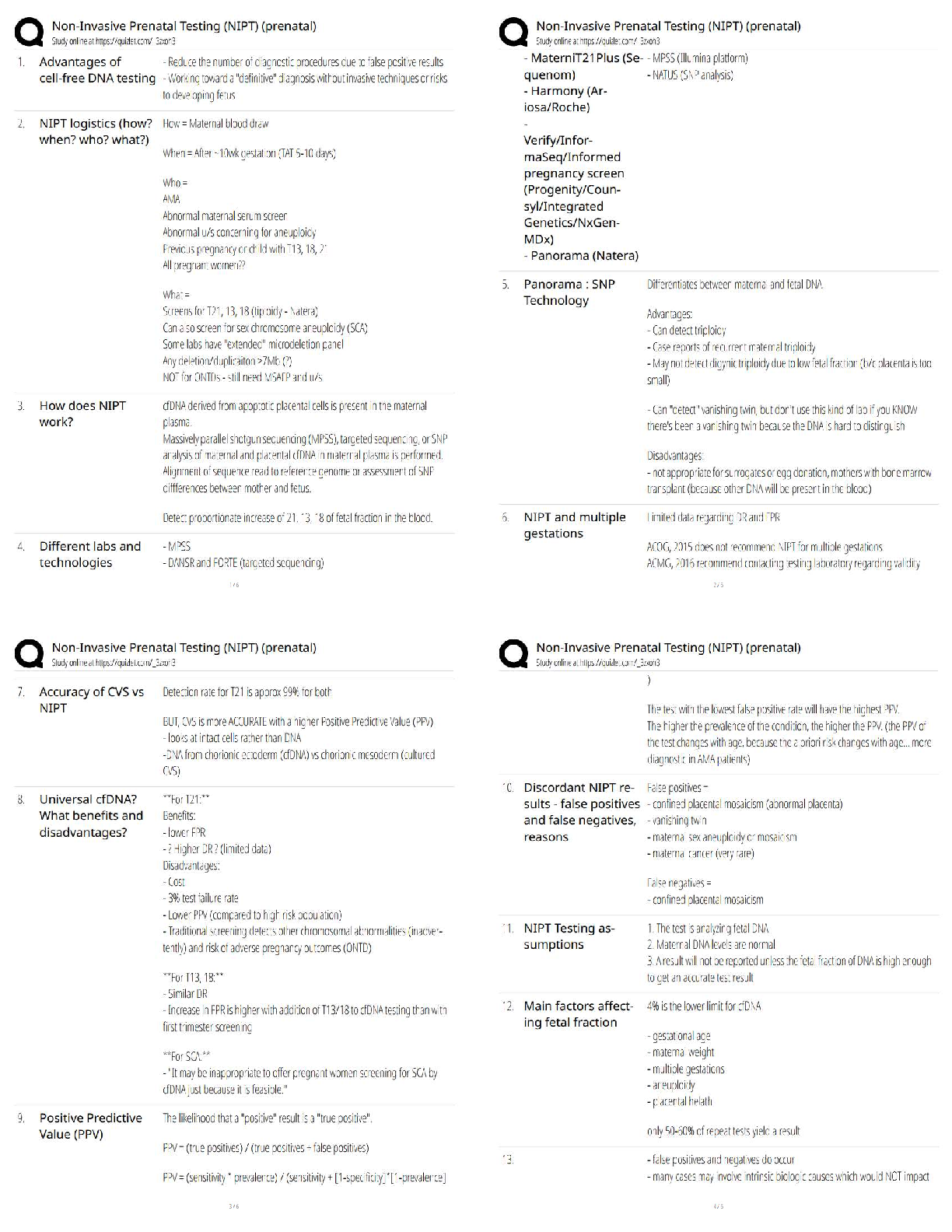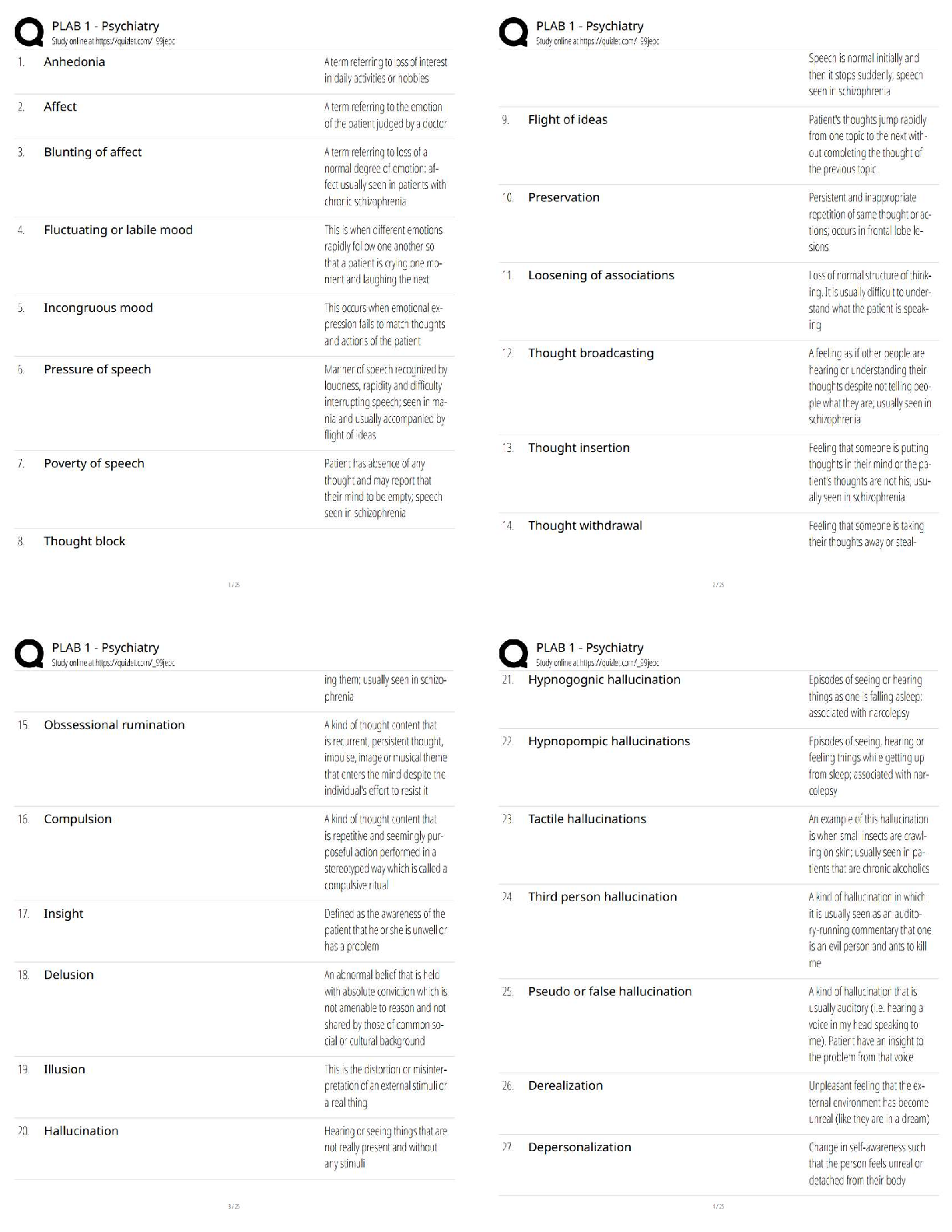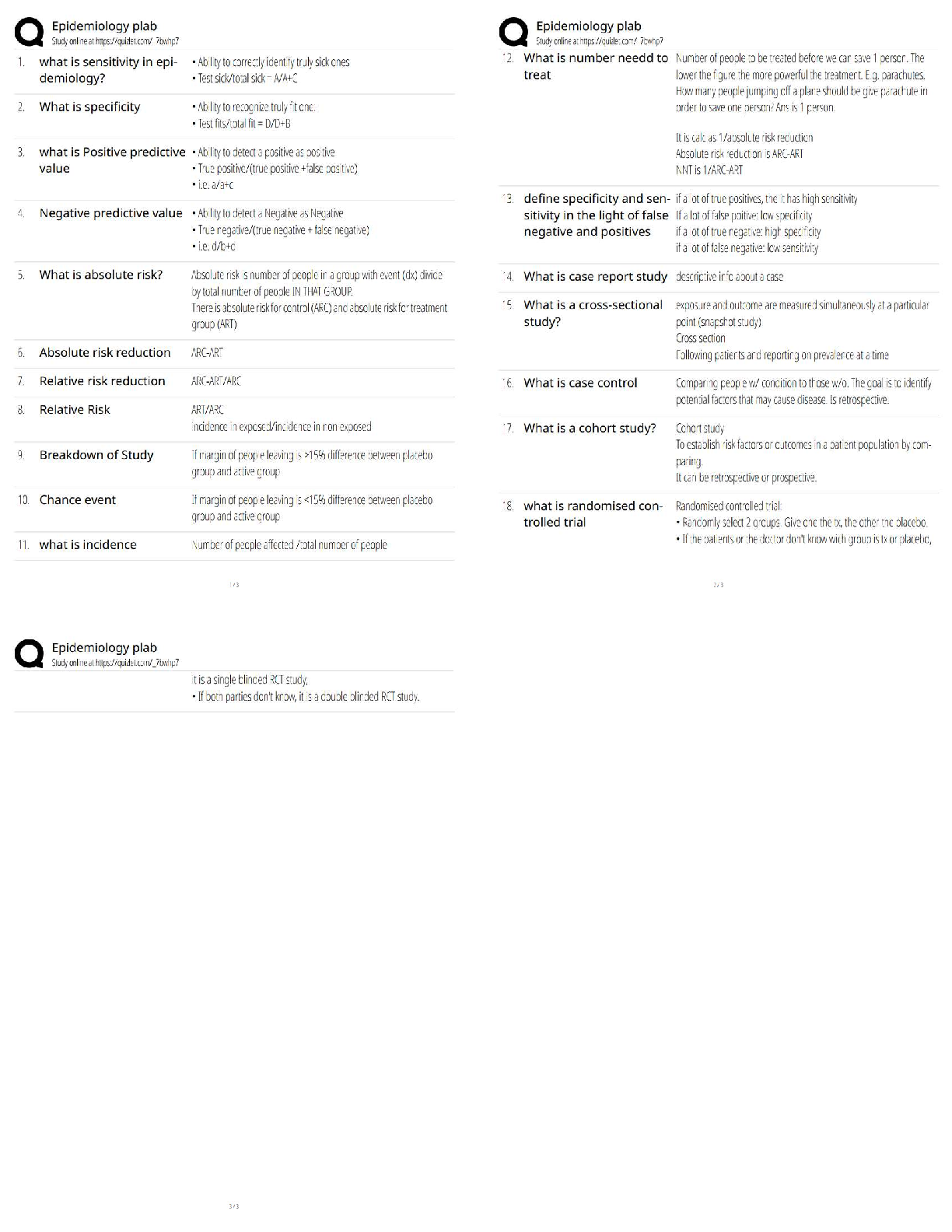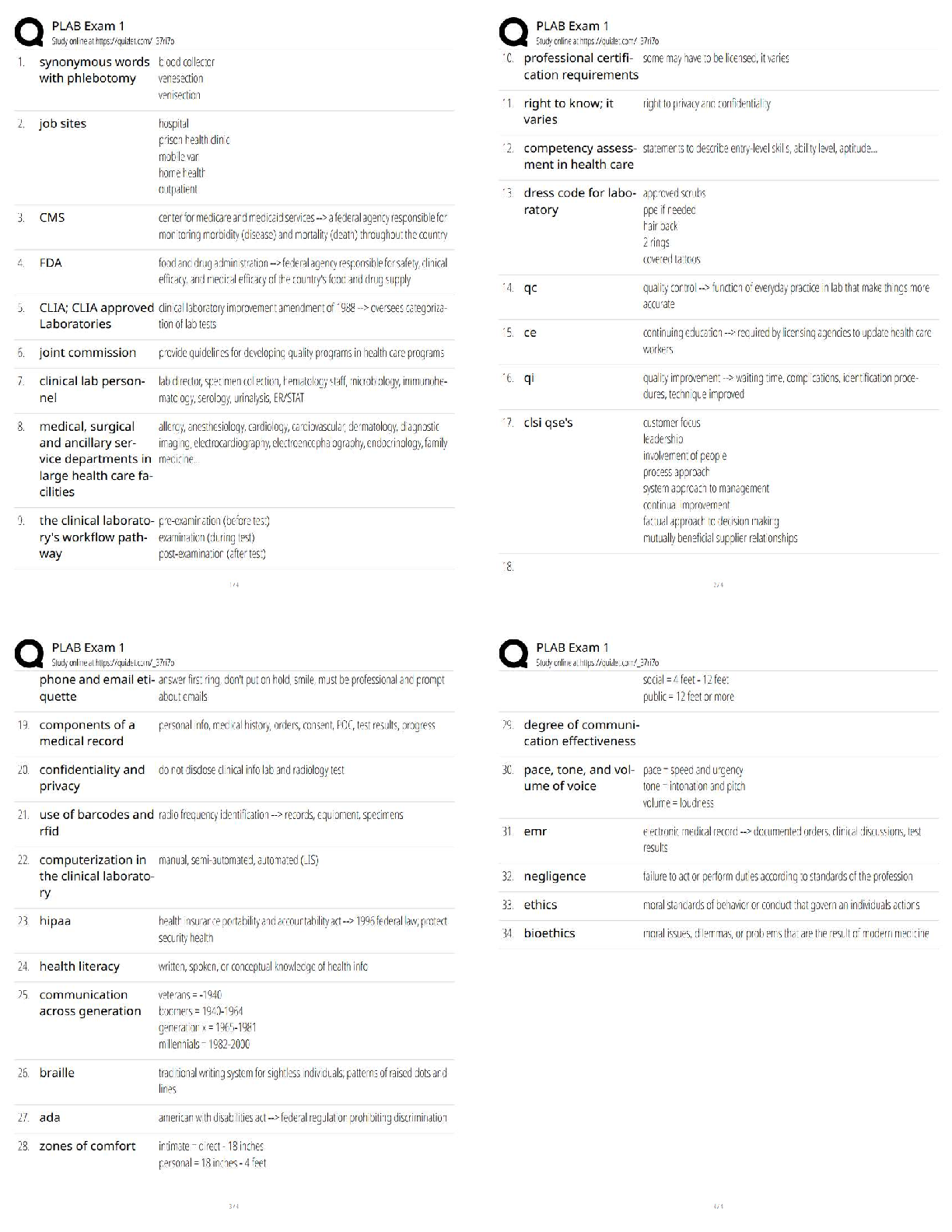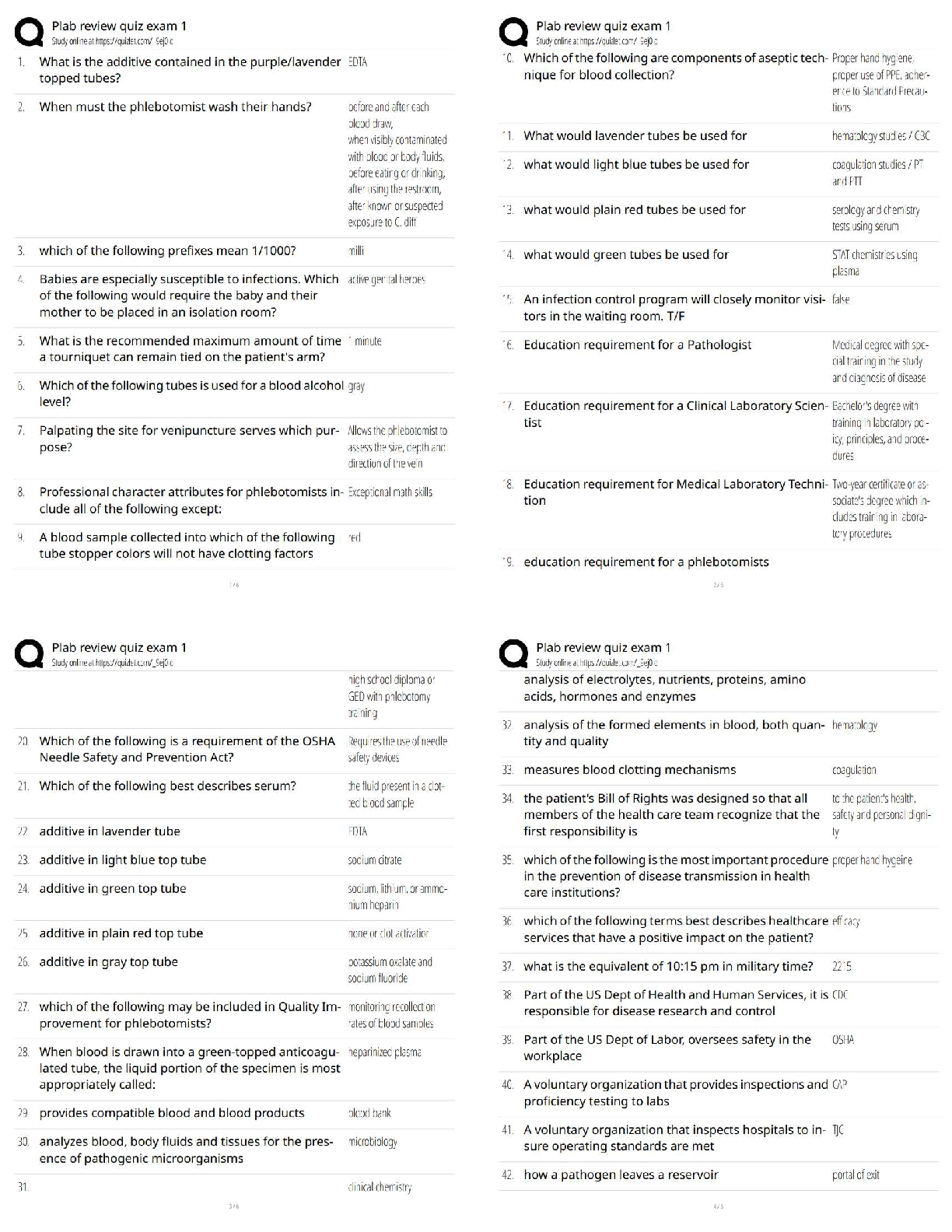*NURSING > QUESTIONS & ANSWERS > NURS 501 Advanced Physiology and Pathophysiology Chapter 1-11 & 28-31 Study Guides (All)
NURS 501 Advanced Physiology and Pathophysiology Chapter 1-11 & 28-31 Study Guides
Document Content and Description Below
1. Which statement best describes the cellular function of metabolic absorption? a. Cells can produce proteins. c. Cells can take in and use nutrients. b. Cells can secrete digestive enzymes. d. Cel ... ls can synthesize fats. 2. Most of a cell’s genetic information, including RNA and DNA, is contained in the: a. Mitochondria c. Nucleolus b. Ribosome d. Lysosome 3. Which component of the cell produces hydrogen peroxide (H2 O2 ) by using oxygen to remove hydrogen atoms from specific substrates in an oxidative reaction? a. Lysosomes c. Ribosomes b. Peroxisomes d. Oxyhydrosomes 4. Which cell component is capable of cellular autodigestion when it is released during cell injury? a. Ribosome c. Smooth endoplasmic reticulum b. Golgi complex d. Lysosomes 5. What is the sequence of steps in the development of a digestive enzyme by the pancreas cells from the initial transcription to the release from the cell? a. The enzyme is transcribed from DNA by RNA in the nucleus, proceeds to the ribosome for synthesis, and is transported in a secretory vesicle to the cell membrane. b. The enzyme is transcribed from RNA by DNA in the nucleus, proceeds to the lysosome for synthesis, and is transported in an encapsulated membrane to the cell membrane. c. The enzyme is transcribed by the mitochondria in the nucleus, proceeds to the ribosome for synthesis, and is transported in a cytoskeleton to the cell membrane. d. The enzyme is transcribed from DNA by RNA in the nucleus, proceeds to the Golgi complex for synthesis, and is transported in cytosol to the cell membrane. 6. During which phase of the cell cycle is DNA synthesized? a. G1 b. S c. G2 d. M 7. What organic compound facilitates transportation across cell membranes by acting as receptors, transport channels for electrolytes, and enzymes to drive active pumps? a. Lipids c. Proteins b. Proteases d. Carbohydrates 8. Understanding the various steps of proteolytic cascades, such as caspase-mediated apoptosis and complement cascades, may be useful in designing drug therapy for which human diseases? a. Cardiac and vascular disorders b. Autoimmune and malignant disorders c. Gastrointestinal and renal disorders d. Endocrine and gastrointestinal disorders 9. Which structure prevents water-soluble molecules from entering cells across the plasma membrane? a. Carbohydrate chains. b. Membrane channel proteins c. Glycoprotein channels d. Lipid bilayer (Phospholipids bi-layer) 10. The fluid mosaic model explains: a. How a cell membrane functions b. Why our bodies appear to be solid c. How tissue is differentiated d. How fluid moves between the intracellular and extracellular compartments 11. Which form of cell communication is used to communicate within the cell itself and with other cells in direct physical contact? a. Protein channel (gap junction) b. Plasma membrane-bound signaling molecules (involving receptors) c. Hormone secretion such as neurotransmitters d. Extracellular chemical messengers such as ligands 12. Which mode of chemical signaling uses blood to transport communication to cells some distance away? a. Paracrine c. Neurotransmitter b. Autocrine d. Hormonal 13. Which mode of chemical signaling uses local chemical mediators that are quickly taken up, destroyed, or immobilized? a. Paracrine c. Neurotransmitter b. Autocrine d. Hormone 14. Neurotransmitters affect the postsynaptic membrane by binding to: a. Lipids c. Amphipathic lipids b. Ribosomes d. Receptors 15. How do cells receive communication from the extracellular fluid surrounding them? a. Protein channel (gap junction) b. Plasma membrane-bound signaling molecules (involving receptors) c. Hormone secretion such as neurotransmitters d. Chemical messengers such as ligands 16. When a second message is necessary for extracellular communication to be activated, it is provided by which one? a. Guanosine triphosphate (GTP) c. Adenosine triphosphate (ATP) b. Adenosine monophosphate (AMP) d. Guanosine diphosphate (GDP) 17. Under anaerobic conditions, what process provides energy for the cell? A.. Oxidative phosphorylation B.. Lactolysis C. Glycolysis D. Passive transport 18. What is the mechanism by which the energy produced from carbohydrates, proteins, and lipids is transferred to adenosine triphosphate (ATP)? a. Anaerobic glycolysis c. Oxidative phosphorylation b. Oxidative cellular metabolism d. Tricarboxylic acid phosphorylation 19. Passive transport is best described with which statement? a. Being driven by osmosis, hydrostatic pressure, and diffusion. b. Involving receptors that can bind with substances being transported. c. Being capable of transporting macromolecules. d. Requiring energy generated by the cell 20. Active transport occurs across which type of membranes? a. Membranes that have a higher concentration of the solute on the outside of the cell b. Membranes that are semipermeable to water and small electrically uncharged molecules c. Membranes that have receptors that are capable of binding with the substances to be transported d. Membranes that have a cell membrane that is hydrophobic rather than hydrophilic 21. Which method of transport uses transmembrane proteins with receptors with a high degree of specificity for the substance being transported? a. Active c. Transmembranous b. Mediated d. Passive 22. The movement of fluid across the arterial end of capillary membranes into the interstitial fluid surrounding the capillary is an example of which fluid movement process? a. Hydrostatic pressure c. Diffusion b. Osmosis d. Active transport 23. Why is osmolality preferred over osmolarity as the measurement of osmotic activity in the clinical assessment of individuals? a. Plasma contains sodium and chloride, which influence the volume of solution. b. Volume affects perfusion more than the weight of solutes. c. More of the weight of plasma is influenced by solutes, such as protein and glucose, rather than by water. d. Osmotic activity depends on the concentration of solutes present in plasma, such as proteins and glucose. 24. A patient who has diarrhea receives a 3% saline solution intravenously to replace the sodium and chloride lost in the stool. What effect will this fluid replacement have on cells? a. Become hydrated c. Shrink b. Swell or burst d. Divide 25. The transport of glucose from the blood to the cell is accomplished by which process? a. Active-mediated transport (active transport) b. Active diffusion c. Passive osmosis d. Passive-mediated transport (facilitated diffusion) 26. Potassium and sodium are transported across plasma membranes by: a. Passive electrolyte channels b. Coupled channels c. Adenosine triphosphatase (ATPase) enzyme d. Diffusion 27. What occurs during exocytosis? a. Macromolecules can be secreted across eukaryotic cell membranes. b. All substances are secreted into the cellular matrix. c. No repairs in the plasma membrane can take place. d. Solute molecules flow freely into and out of the cell. 28. Why is it possible for potassium to diffuse easily into and out of cells? a. Potassium has a greater concentration in the intracellular fluid (ICF). b. Sodium has a greater concentration in the extracellular fluid (ECF). c. The resting plasma membrane is more permeable to potassium. d. An excess of anions are inside the cell. 29. The cellular uptake of the nutrient cholesterol depends on which process? a. Receptor-mediated exocytosis c. Receptor-mediated endocytosis b. Antiport system d. Passive transport 30. What causes the rapid change in the resting membrane potential to initiate an action potential? a. Potassium gates open, and potassium rushes into the cell, changing the membrane potential from negative to positive. b. Sodium gates open, and sodium rushes into the cell, changing the membrane potential from negative to positive. c. Sodium gates close, allowing potassium into the cell to change the membrane potential from positive to negative. d. Potassium gates close, allowing sodium into the cell to change the membrane potential from positive to negative. 31. The action of platelet-derived growth factor is to stimulate the production of which cells? a. Platelets c. Connective tissue cells b. Epidermal cells d. Fibroblast cells 32. The role of cytokines in cell reproduction is that they: a. Provide growth factor for tissue growth and development. b. Block progress of cell reproduction through the cell cycle. c. Restrain cell growth and development. d. Provide nutrients for cell growth and development. 33. What is the process of cellular reproduction? a. The process often takes months or years to complete. b. Cellular reproduction typically has a short interphase. c. Two diploid cells, called daughter cells, have been formed. d. The process involves the interaction of male and female cells. 34. Which statement is true about eukaryotic cells? a. They lack distinct nucleus. b. They contain compartments called organelles. c. They lack an encasing nuclear membrane. d. They are smaller than the typical prokaryote cell. 35. Which statement is true about phagocytosis? a. Phagocytosis is an example of exocytosis. b. Phagocytosis is dependent on small vesicles. c. Phagocytosis involves the ingestion of bacteria. d. Phagocytosis focuses on solute molecules. 36. A muscle cell possesses which specialized function? a. Movement c. Secretion b. Conductivity d. Respiration 37. When a mucous gland cell creates a new substance from previously absorbed material, this process is known as which specialized cellular function? a. Excretion c. Reproduction b. Metabolic absorption d. Secretion 38. All cells are capable of what process? a. Excretion c. Metabolic absorption b. Movement d. Continuous division Multiple Response Identify one or more choices that best complete the statement or answer the question. 39. What are the major chemical components of the cell membranes? (Select all that apply.) a. Lipids. b. Sodium ions c. Carbohydrates d. DNA e. Proteins 40. Which cells lose their ability to replicate and divide? (Select all that apply.) a. Intestines b. Nerves c. Skin d. Lens of the eye e. Skeletal muscle 41. Which statements are true concerning the process of facilitated diffusion? (Select all that apply). a. Facilitated diffusion is also referred to as passive mediated transport. b. This process expends no metabolic energy. c. Moving solute molecules through cellular membranes are involved in this process. d. Movement up a concentration gradient is necessary. e. Facilitated diffusion is the primary means for water transport. 42. Passive transport is dependent on: (Select all that apply.) a. Semipermeable barrier membrane b. The process of osmosis c. Diffusion as a driving force d. A living host e. Hydrostatic pressure 43. What is the primary function of proteins? (Select all that apply.) a. Proteins are binding units. b. Proteins are transport channels. c. Proteins are ribonucleoproteins. d. Proteins provide cell surface markers. e. Proteins are chemical reaction catalysts. Matching Match the structure with its function. Answers may be used more than once. A. Endoplasmic reticulum B. Ribosome C. Secretory vesicle D. Lysosomes 44. Packages and transports proteins. Endoplasmic reticulum, Ribosome 45. Fuses with the plasma membrane to release contents from the cell. Secretory Vesicle 46. Synthesizes and transports lipids. Endoplasmic reticulum 47. Provides energy to digest proteins into amino acids. Lysosomes Match the structure with its function. Answers may be used more than once. A. Passive-mediated transport B. Active-mediated transport C. Osmosis 48. Movement of water Osmosis 49. Protein carrier Passive-mediated transport & Activemediated transport 50. Facilitated diffusion Passive-mediated transport Thought Questions 1. With respect to chemical communication and signal transduction, A. Describe three ways in which cells communicate with one another; give an example of each. 1. protein channels (gap junctions) coordinate activity with adjacent cells 2. PM-bound signaling molecules (receptors) affect itself and others in direct contact 3. secrete chemical signals (ligands) b. five forms of signaling mediated by secreted molecules; give an example of each. Intracrine ligands are produced by the target cell itself and bind to a receptor within. Autocrine ligands are finely distinct in that although they are also made by the target cell, they are first secreted and then later bind to the cell as well as neighboring cells (ex. Immune cells). Juxtacrine ligands target adjacent cells (often called “contact-dependent” signaling). Paracrine ligands target cells in the vicinity of the original emitting cell (ex. Neurotransmitters like Acetylcholine). Endocrine cells produce hormones that have the important task of targeting distant cells and often travel through our circulatory system. 2. Describe an example of a molecule(s) transported by active mediated transport (facilitated diffusion); describe active transport and the sodium-potassium pump. An example of facilitated diffusion is the movement of glucose into the cell, where it is used to make ATP. Their diffusion is facilitated by membrane proteins that form sodium channels (or “pores”) so that Na+ ions can move down their concentration gradient from outside the cells to inside the cells. 3. Describe the steps of the cAMP second messenger pathway and identify several cell responses to common neurotransmitters and steroids, which are first messenger molecules to cAMP second messenger pathway. -Second messengers are intracellular signaling molecules released by the cell in response to exposure to extracellular signaling molecules—the first messengers. First messengers are extracellular factors, often hormones or neurotransmitters, such as epinephrine, growth hormone, and serotonin. -AC Pathway. The AC pathway begins with an outside signal, such as a hormone, that binds to a receptor on a cell surface. The receptor then activates a G-protein by causing a change from GDP to GTP. The alpha piece of Gs, when activated, tells the AC to begin changing ATP to Cyclic adenosine monophosphate (cAMP, cyclic AMP, or 3',5'-cyclic adenosine monophosphate) . -cAMP is a second messenger important in many biological processes. cAMP is a derivative of adenosine triphosphate (ATP) and used for intracellular signal transduction in many different organisms, conveying the cAMP-dependent pathway for the activation of specific proteins. [Show More]
Last updated: 3 years ago
Preview 1 out of 112 pages

Buy this document to get the full access instantly
Instant Download Access after purchase
Buy NowInstant download
We Accept:

Reviews( 0 )
$24.50
Can't find what you want? Try our AI powered Search
Document information
Connected school, study & course
About the document
Uploaded On
Oct 22, 2020
Number of pages
112
Written in
All
Additional information
This document has been written for:
Uploaded
Oct 22, 2020
Downloads
0
Views
126

